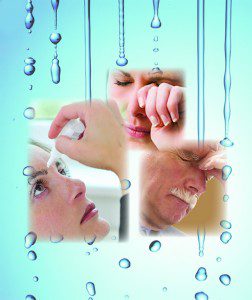It’s estimated that 33 million Americans have some form of Dry Eye Disease.
 Tears are more than a means of expressing sadness and joy—they’re an essential part of maintaining healthy eyes and good vision. When our tears are functioning well, we don’t even think about them. But when they don’t, we begin to notice the following symptoms:
Tears are more than a means of expressing sadness and joy—they’re an essential part of maintaining healthy eyes and good vision. When our tears are functioning well, we don’t even think about them. But when they don’t, we begin to notice the following symptoms:
• Stinging and itching
• Burning sensation
• Inflammation, redness
• Sandy, gritty feeling
• Sensitivity to light
• Blurry vision
• Excessive tearing
Excessive tearing? How can this be a symptom of Dry Eye Disease (DED)? Because healthy tears are made up of a specific formula containing three components: an outer layer of oil, a middle layer of water, and an inner layer of mucus. If this composition of the tear is out of balance, your eyes will not be lubricated sufficiently. And, when the cornea becomes too dry, tear glands will overcompensate and stimulate too much of the watery component. Odd as it seems, your eyes can be overflowing with tears and still be “dry”.
Why Do We Get Dry Eyes?
There are many reasons for this to happen. Aging is one of the most common causes. Environment plays a role as well—hot, dry and windy weather as well as heaters and/or air conditioners may be a problem. Ceiling fans that blow directly on you at night could be another reason you wake up with that scratchy, sandy feeling. Computer use is also a big issue, because computer users have a way of just staring at the screen for long periods of time and forgetting to blink. In younger people, this non-blinking behavior is a marked cause of dry eyes, as is long term use of contact lenses. Even problems with your eyelids can cause dry eyes. Sometimes the lids will turn outward (ectropion) or inward (entropion); conditions which can be addressed surgically. Inflamed eyelids (blepharitis) may be another cause. Certain types of medical conditions, such as rheumatoid arthritis, psoriasis, eczema, and Sjogren’s syndrome to name just a few, can cause problems with dryness. Lastly, certain medications, like antihistamines or diuretics can produce dry eye symptoms, as can a deficiency of some vitamins.
What Treatments Can Help ?
If you have symptoms, visit your eye doctor to confirm a diagnosis. The Eye Associates is an Accredited Dry Eye Center, and can perform an osmolarity test, (saltiness of your tears) which analyzes the quality of your tears in order to recommend a treatment plan.
Dry Eye Disease is generally a condition that is not cured (depending on the cause), but it can be managed. Treatment options usually fall in four categories: increasing the amount of tears kept in the eyes, decreasing tear evaporation, treating inflammation and addressing eyelid function. Keep in mind that DED is frustrating and requires patience. It is a complex medical problem that has no quick fixes, and one that may need several therapies before finding a treatment that works for you.
Mild dry eye symptoms are usually addressed with artificial tears to lubricate the cornea. There are many over-the-counter drops and ointments designed to enhance natural tears. Ointments are best for night use because they will blur your vision. We suggest that you try different brands of artificial tears to see which one is best for your eyes. We do want to warn you against choosing an eyedrop that ‘takes the red out.’ These eyedrops tend to irritate the eye even more. Also, because some people are allergic to drops with preservatives, we recommend single-use drops.
Some other treatment options include Restasis prescription eyedrops, punctal plugs, scleral lenses, Bruder Eye Hydrating Compress, vitamin therapy, lid scrubs, and eyelid function surgery.
Autologous Serum Tears—A Biological Advantage
The Eye Associates is one of the few practices that offer serum tear treatment for patients with severe dry eye disease. Since artificial tears lack the biologically active elements found in our natural tears, eyedrops made from components derived from one’s own body have been found to be very beneficial. These eyedrops, called autologous serum tears, are made by separating components of a patient’s own blood. The benefit is that these man-made tears possess the biological nutrients naturally found in our own tears. It should be noted that this treatment is normally not covered by insurance.
“Eye-Friendly Foods”—A Nutritional Approach
Help DED symptoms by modifying your diet to include foods that fight inflammation. Omega 3 (fish oil) is a go-to supplement that many find beneficial. The Eye Associates has developed a cookbook Ebook specifically designed to help the Dry Eye patient. It’s FREE. Just download it from www.TheEyeAssociates.com.
The Eye Associates
Cathleen McCabe, MD
Brian Foster, MD
Robert S. Friedman, MD
Richard E. Hector, MD
Joshua Mali, MD
Todd Berger, MD
Jeffrey Kasper, MD
Ahmad Tarabishy, MD
Charles Anthony II, MD
Scott B. Han, OD
Michael Camp, OD
Edwin Detweiler III, OD
Lori Ann Long, OD
Robert Rego, OD
David M. Rubin, OD
Toll Free: 1-866-865-2020
www.Sight4Life.com
WEST BRADENTON:
6002 Pointe West Blvd
EAST BRADENTON:
7230 55th Avenue East
ELLENTON:
7915 US Hwy 301 North, # 101
SARASOTA:
2111 Bee Ridge Road
SUN CITY CENTER:
3894 Sun City Blvd
WEST BRADENTON:
Dermatology & Hearing only
2101 61st Street West
VENICE:
250 South Tamiami Trail, #103








